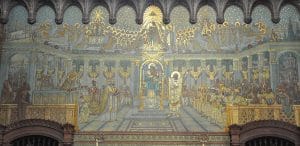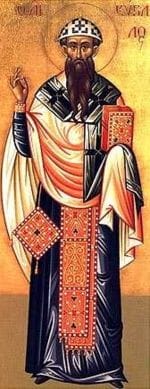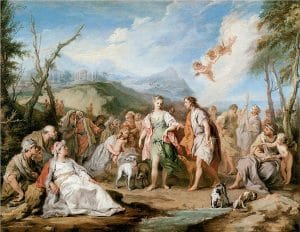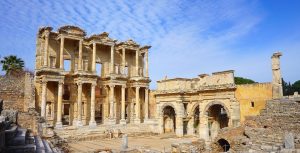Blog Titles
ToggleEphesus Council in Ephesus Ancient City
It was gathered in the church of the Virgin Mary in Ephesus in 431 because of the controversial teachings of the Patriarch of Istanbul Nestorius. Patriarch Cyril of Alexandria accused Nestorius of heresy and appealed to Pope Celestine I. The Pope agreed, authorizing Cyril to inform Nestorius that he should work to change his mind or he would be excommunicated. Before the call came, Nestorius Emperor II.
 He persuaded Theodosius to convene a general council where he could discuss his opposing views. About 250 bishops were found in the Council. The conference passed in an atmosphere of mutual defiance and blaming each other. It is considered the 3rd ecumenical consul of Eastern and Western Orthodox, Roman Catholics, and many other Western Christians. On the other hand, Ephesus was rejected by the Church of the East (English: Church of the Orient).
He persuaded Theodosius to convene a general council where he could discuss his opposing views. About 250 bishops were found in the Council. The conference passed in an atmosphere of mutual defiance and blaming each other. It is considered the 3rd ecumenical consul of Eastern and Western Orthodox, Roman Catholics, and many other Western Christians. On the other hand, Ephesus was rejected by the Church of the East (English: Church of the Orient).
Nestorius told Jesus that the Word descended when he was 30 years old, but that he had the characters of Man and God ever since, that Mary was the mother of Jesus, who was man, not Jesus, who was God, and therefore told Mary that “God He objected to being called the “mother of God” (Theotokos) and stated that God would not confirm, that he was not born.
According to Nestorius, Jesus’ human identity and his divine identity are separate from each other; for this reason, the Nestorius doctrine is called diophysite (“two naturalists“) in some sources. According to this view, the divine nature was separated from Jesus while he was crucified, only the human Jesus suffered, and his sufferings did not touch the God, Jesus.
 The innovation of Nestorius, Bishop of Constantinople, is known; how he divided into two the person of Christ. Pope St. Celestine, watchful, according to his office, over the affairs of the Church, had charged the blessed Cyril, Bishop of Alexandria, to send him a certain report of the doctrine of Nestorius, already in bad repute. Cyril declares this in his letter to Nestorius, and so he writes to Celestine a complete account and sets forth the doctrines of Nestorius and his own; he sends him two letters from himself to Nestorius, who likewise, by his letters and explanations, endeavored to draw Celestine to his side.
The innovation of Nestorius, Bishop of Constantinople, is known; how he divided into two the person of Christ. Pope St. Celestine, watchful, according to his office, over the affairs of the Church, had charged the blessed Cyril, Bishop of Alexandria, to send him a certain report of the doctrine of Nestorius, already in bad repute. Cyril declares this in his letter to Nestorius, and so he writes to Celestine a complete account and sets forth the doctrines of Nestorius and his own; he sends him two letters from himself to Nestorius, who likewise, by his letters and explanations, endeavored to draw Celestine to his side.
Thus the holy Pontiff, having been most fully informed by letters from both sides, is thus inquired of by Cyril. “We have not confidently abstained from Communion with him (Nestorius) before informing you of this; condescend, therefore, to unfold your judgment, that we may know whether we ought to communicate with him who cherishes such erroneous doctrine.”
And he adds, that his judgment should be written to the other Bishops also, “that all with one mind may hold firm in one sentence.” Here is the Apostolic See manifestly consulted by so great a man, presiding over the second, or at least the third, Patriarchal See, and its judgment awaited, and nothing remained but that Celestine, being duly consulted, should perform his Apostolic office.
But how he did this, the Acts have shown. In those Acts, he not only approves the letters and doctrine of Cyril, but disapproves, too, the perverse dogma of Nestorius, and that distinctly, because he was unwilling to call the Blessed Virgin Mother of God: and he decrees that he should be deprived of the Episcopate and Communion unless, within ten days from the date of the announcing of the sentence, he openly rejects this faithless innovation, which endeavors to separate what Scripture joineth together—that is, the Person of Christ.
Here is the doctrine of Nestorius expressly disapproved, and a sentence of the Roman Pontiff on a matter of Faith most clearly pronounced under threat of deposition and ex-communication: then, that nothing be wanting, the holy Pope commits his authority to Cyril to carry into execution that sentence “associating,” he saith to Cyril, “the authority of our See, and using our person, and place, with power.”
So to Cyril; so to Nestorius himself; so to the clergy of Constantinople; so to John of Antioch, then the Bishop of the third or fourth Patriarchal See; so to Juvenal, Bishop of the Holy City, whom the Council of Nice had ordered to be especially honored: so he writes to the other Bishops also, that the sentence given may be duly and in an order made known to all. Cyril proceeds to execute his office and performs all that he had been commanded.
He promulgates and executes the decrees of Celestine; and declares to Nestorius, that after the ten days prescribed and set forth by Celestine, he would have no portion, intercourse, or place with the priesthood. Nothing is wanting the Apostolical authority to be most fully exercised.
Ecumenical Councils
Before it became Constantinople, the name of the city was Byzantium. It was an insignificant diocese of Heraklea (Marmara-Ereğlisi) within the church hierarchy before the Council of Nicaea. We have no information about the first bishop “Metrophanes”. According to the church historian Sozomenos, the bishop “Alexandros” (probably Macedonian metropolitan) who might be the first according to the next two suspicious documents, the bishop of Thessaloniki, one of the participants of the Nicaean council, was the bishop of Alexandros, which started from 314 (Milan agreement 313), which he stated to show himself with his miracles rather than his intellectual ability.
It lasts for years, this period has been quiet for him, he has been away from political struggles, and the diocese has preserved its insignificance because its sphere of activity has not been defined. After his death, the period of Arian bishops, which will last for 40 years, will begin. During his lifetime, 325 Councils of Nicaea were convened and Byzantion was declared “Nova Roma” on May 13, 330.
The 1st Ecumenical (universal) Council was convened in 325 at the call of Emperor Constantine, theological disagreements were discussed, and Arianism was condemned (actually, Arianism was condemned by Alexandros bishop Alexandros and in the Egyptian council in 318, which was attended by one hundred bishops).
The Christian faith and church organization were shaped in the council. Only Rome, Alexandria, and Antioch centers were mentioned in the 6th rule of the council, and the Jerusalem church was honored after these three churches with the 7th rule, and the rights of the metropolitans were restricted. These three centers mentioned in the first Ecumenical Council were established by the apostles, and their apostolic origins were called the “Ecumenical Patriarchate”, and their apostolic origins were undisputed, and Jerusalem was honored with a separate article.
In the Council of Iznik, Byzantion was accepted as a diocese attached to the metropolitan of Heraklea. It may be natural that it is not included in the hierarchical order above because it is not yet the capital city.
Council of Constantinople 381: Arius was condemned in the Council of Nicaea, but the Arianists continued to spread their thoughts, so conflicts broke out. Various synods were convened during the reign of Constantius. In this turbulent period, Pope Julius I made an important statement in terms of the history of the councils and suggested that the acceptance of a council as an Ecumenical would be possible not with the invitation of the Emperor, but with the acceptance of the decisions of the council by all churches.
It is regional, not Ecumenical, which Theodosius gathered in 381, Theodosius controlled the eastern part of the country, and nobody came from the west except the bishop of Thessaloniki. Most of the participants, attended by the 150 bishops, came from Anatolia, Syria, and Palestine, which Antakya controlled, not counting the lesser numbers of later Alexandria-controlled Egyptian bishops.
The principles of belief accepted in the Istanbul council, Iznik, were accepted and teachings on the Holy Spirit were developed. The council also bypassed the 6th Rule of the Council of Nicaea and placed the bishopric of Istanbul in second place after Rome and before Alexandria (Canon 3).
In a non-ecumenical council, giving Istanbul the patriarchate status and placing it in the 2nd rank among the patriarchates is a political act, a violation of the 6th rule of the first Ecumenical council.
Rome did not accept this situation and Alexandria and Antakya remained silent. Since the 3rd pedestal of the Istanbul council offended Rome, Rome ignored this rule but recognized Istanbul’s second place in the 1215 Lateran council, but at that time Istanbul was under the invasion of the Crusaders and there was a Latin patriarch.
The 3rd pedestal of the Istanbul council, which placed Istanbul in second place, had its main effect on Alexandria, and Alexandria won this 70-year-long struggle between Istanbul and Alexandria.
Council of Ephesus 431: The fall of the patriarchate of Alexandria in honorary order caused intense reactions in the East, the patriarch of Alexandria Theophilos dismissed the Istanbul patriarch Chrysostomos with the synod he convened, and this decision of impeachment was approved by the Emperor.
The second great victory of Alexandria is the condemnation of another bishop of Istanbul. This event is the condemnation of Nestorius, the patriarch of Istanbul, in the council of Ephesus in 431, “accepting the view that Jesus had a unique personality and two natures”. In this council, the 3rd pedestal of the Istanbul council was not touched, but the capital’s patriarch was convicted in a holy council and a subordinate of the patriarch of Alexandria was appointed here, de facto superior of Alexandria.
Ephesus Council 449: (Synod of Bandits) The Monophysite view, which was accepted in the Ephesus council with the efforts of the Patriarchate of Alexandria, encountered the opposition of the Istanbul patriarch Flavianus and Pope Leon I. Flavianus declared Eutyches of the Monophysite school heretical and condemned him in Istanbul, whereupon the patriarch of Alexandria had Emperor Theodosius convene a new Ecumenical council.
Monophysitism was accepted in the council convened in Ephesus in 449, and it resulted in a new victory of the Patriarch of Alexandria over Istanbul. The patriarch of Istanbul, Flavianus, was dismissed, in other words, it shows that Alexandria was in a position on Istanbul.
Kadikoy Council 451: 449 Pope Leo I, who protested against the Ephesus council, called it the “Bandits Council” and demanded a new council from the emperor, but it did not happen with the death of the emperor. The new emperor Marcian convened a council in Kadıköy, and this council was accepted as the 4th Ecumenical Council from the East and West.
In this council, monophysitism was rejected and Jesus’ dual nature was accepted. In this council, the views of the patriarchate of Alexandria were rejected and the claim of superiority in the east was ended. The 28th rule of this council confirmed the 3rd rule of the Istanbul council and placed Istanbul as the “New Rome” in second place after the old Rome. He elevated the Jerusalem church to the status of a patriarchate, and thus all five patriarchates were declared to be of apostolic origin. They shared jurisdictions over the known world outside of Cyprus.
Papal delegates protested these decisions, Pope Leo I strongly rejected the 28th rule and stated the privileged status of Rome, Antioch, and Alexandria, that the churches here were founded by the apostles, whereas Istanbul was not of the same quality, that is, it was not apostolic, Pope wrote to Marcian. In the letter, he stated that the 28th Rule was not accepted because it was contrary to the 3rd Rule of Iznik.
Istanbul Councils 476 and 508: In 475, Basilikos went to Egypt due to the uprisings that took the throne, and on his return, he convened an Ecumenical council in Istanbul in 476 to please the Eastern Christians. In this council, the decisions taken in Kadıköy were declared illegitimate, and the decisions contrary to İznik 325 were condemned. The Ecumenical status of the Istanbul patriarchate was abolished, and the emperor accepted it with an edict.
The participants of the council went to Ephesus and gathered a synod under the presidency of Timoteus, patriarch of Alexandria, who declared the decisions of the Kadıköy council illegitimate and excommunicated the patriarch of Istanbul. This has been interpreted as seeing Istanbul as a diocese attached to Ephesus.
With the change of power, the emperor Zenon tried to create an environment of peace by issuing a union edict, which was supported by the Istanbul patriarch Acacius, but Pope Simplicius excommunicated him.
In 508, another council was convened in Istanbul and the patriarch of Istanbul, the 2nd Macedonian, was excommunicated. In other words, within one hundred and fifty years, the eastern churches had excommunicated five Istanbul patriarchs.
Fifth General Council 553: The council convened by Justinian was accepted as the 5th Ecumenical Council. The Roman representatives prepared a document that reduced the patriarch of Istanbul to a local status, had the capital Patriarch sign it, and declared it to the emperor with an edict. In 595, the use of the title of Ecumenical by the patriarch of Istanbul angered Pope Gregory I, and asked the emperor Phocas to ban its use.
Sixth General Council 680: Although it was gathered under the name of the General Council, it only dealt with the discipline issues of the Eastern Church. Kadıköy 28th Rule was accepted again, but Pope Agatho did not accept the decisions taken.
Claim of apostolic origin: Byzantine fanatics claimed that the episcopate of Istanbul was founded by the apostle Andreas, and even the bones of St. Andreas were brought to Istanbul to increase his prestige, but they were of no importance to the Byzantines.
Daily life in Ephesus – About Ephesus
- Ephesus Gods and Goddess
- About Ephesus history
- Festivals in Ephesus ceremony and procession
- Ephesus city management
- Sex life in Ephesus
- Burial in Ephesus
- How was childhood in the ancient city of Ephesus in Greek and Roman times?
- What did women do for their beauty in ancient Ephesus?
- How was the Marriage? Get married in daily life in Ephesus
- Ancient Ephesus food beverage cuisine and meal
- Gladiators in Ephesus
- Clothing and fashion in Ancient Ephesus
- Ephesus The Comedy of Errors – Shakespeare
- St. Paul in Ephesus
- Virgin Mother Mary in Ephesus
- Ancient Ephesus Marbles
- Ancient Ephesus History
- Slavery in Ephesus
- Ephesus Council – Biblical Ephesus
- Ephesus Temple, Ephesus Offerings Votives





